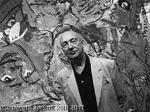Georg Baselitz
Georg Baselitz
Style: Neo Expressionism;
Born: 1938
Biography:
Georg Baselitz is a German painter, sculptor and graphic artist. In the 1960s he became well known for his figurative, expressive paintings. Since 1969, he paints his subjects upside down in an effort to overcome the representational, content-driven character of his earlier work and stress the artifice of painting. Drawing from a myriad of influences, including art of Soviet era illustration art, the Mannerist period and African sculptures, he developed his own, distinct artistic language.
Since Baselitz grew up amongst the suffering and demolition of World War II, the concept of destruction plays a significant role in his life and work. These autobiographical circumstances have therefore returned throughout his whole oeuvre. In this context, the artist stated in an interview: "I was born into a destroyed order, a destroyed landscape, a destroyed people, a destroyed society. And I didn't want to reestablish an order: I had seen enough of so-called order. I was forced to question everything, to be 'naive', to start again." By disrupting any given orders and breaking the common conventions of perception, Baselitz has formed his personal circumstances into his guiding artistic principles. To this day, he still inverts all his paintings, which has become his unique and most defining feature in his work.
Baselitz was born on 23 January 1938, in Deutschbaselitz (now a part of Kamenz, Saxony), in what was later East Germany. His father was an elementary-school teacher and the family lived in the local school building. Baselitz attended the local school in Kamenz. In its assembly hall hung a reproduction of the painting Wermsdorfer Wald (1859) by Louis-Ferdinand von Rayski, an artist whose grasp of Realism was a formative influence on Baselitz. Moreover, Baselitz was interested the writings of Jakob Böhme. At the ages of 14 and 15, he already painted portraits, religious subjects, still lifes and landscapes, some in a futuristic style.
In 1955, he applied to study at the Kunstakademie in Dresden but was rejected. In 1956, he successfully enrolled at Hochschule für Bildende und Angewandte Kunst in East Berlin. There he studied under professors Walter Womacka and Herbert Behrens-Hangler, and befriended Peter Graf and Ralf Winkler (later known as A. R. Penck). After two semesters however, he was expelled for "sociopolitical immaturity" because he did not comply with the socialist ideas of the DDR. Baselitz' distinic and controversial nature already becomes apparent this early on in his career.
In 1957, he resumed his studies at Hochschule der Künste in West Berlin, where he settled down and met his future wife Johanna Elke Kretzschmar. In 1961, he attended Hann Trier's master class and completed his studies the following year. Hann Trier's classes were described as a creative environment largely dominated by the gestural abstraction of Tachism and Art Informel. At the Hochschule der Künste Baselitz immersed himself in the theories of Ernst Wilhelm Nay, Wassily Kandinsky and Kasimir Malevich. During this time he became friends with Eugen Schönebeck and Benjamin Katz. Art historian Andreas Franzke describes Baselitz primary artistic influences at this time as Jackson Pollock and Philip Guston.
In 1961, he adopted the name Georg Baselitz as a tribute to his home town.
Since 2013, Baselitz and his wife live in Salzburg in Austria and both obtained Austrian citizenship in 2015. He married Kretzschmar in 1962 and is the father of two sons, Daniel Blau and Anton Kern, both galerists.
In 1957, Baselitz produced his first original works in a distinct style of his own, among them the imaginary portraits Uncle Bernhard (Onkel Bernhard). In the same year, he started work on the Rayski-Head (Rayski-Kopf) series.
In 1963, Baselitz's first solo exhibition in West Berlin, at Galerie Werner & Katz, caused a public scandal. Two of the pictures, The Big Night Down The Drain (Die große Nacht im Eimer) (1962/63) and the Naked Man (Nackter Mann) (1962), were seized by the public prosecutor on the ground of their lewd and obscene content, after a friend had already announced their being seized in a local newspaper - a self-fulfilling prophecy and intentional scandal. The ensuing court case did not end until 1965.
Baselitz spent the spring of 1964 at Schloß Wolfsburg and produced his first etchings in the printing shop there, which were exhibited later that year. The next year, he won a six-month scholarship to study at the Villa Romana in Florence. While there, he studied Mannerist graphics and produced the Animal Piece (Tierstück) pictures. In general, Baselitz' greatest inspiration stems from artists such as Pablo Picasso, Alberto Giacometti, Joseph Beuys, as well as from the expressionist artist association Die Brücke.
After returning to West Berlin twenty years after the war, between 1965 and 1966, Baselitz created the series of Heroes (Helden, also known as Neue Typen), which, among others, includes the large-format composition The Great Friends (Die großen Freunde, Museum Ludwig, Cologne). These figures represent a metaphorical image of a man who, having neither nationality nor an affiliation to a place, throws the illusory and megalomaniacal ideals of the Third Reich and East Germany overboard with his desolate, broken, ragged appearance. Baselitz' Helden typically appear alone in a barren landscape with naked arms and legs, and hands opened in a summoning gestures. At times they bear attributes associated with the biography of the artist, who refers to his own childhood in the countryside and identifies himself with all of them. Through early 1969, he produced further large-format pictures, such as Foresters (Waldarbeiter) as part of a group of pictures known as Fractures (Frakturbilder).
More...
Wikipedia link: Click Here









